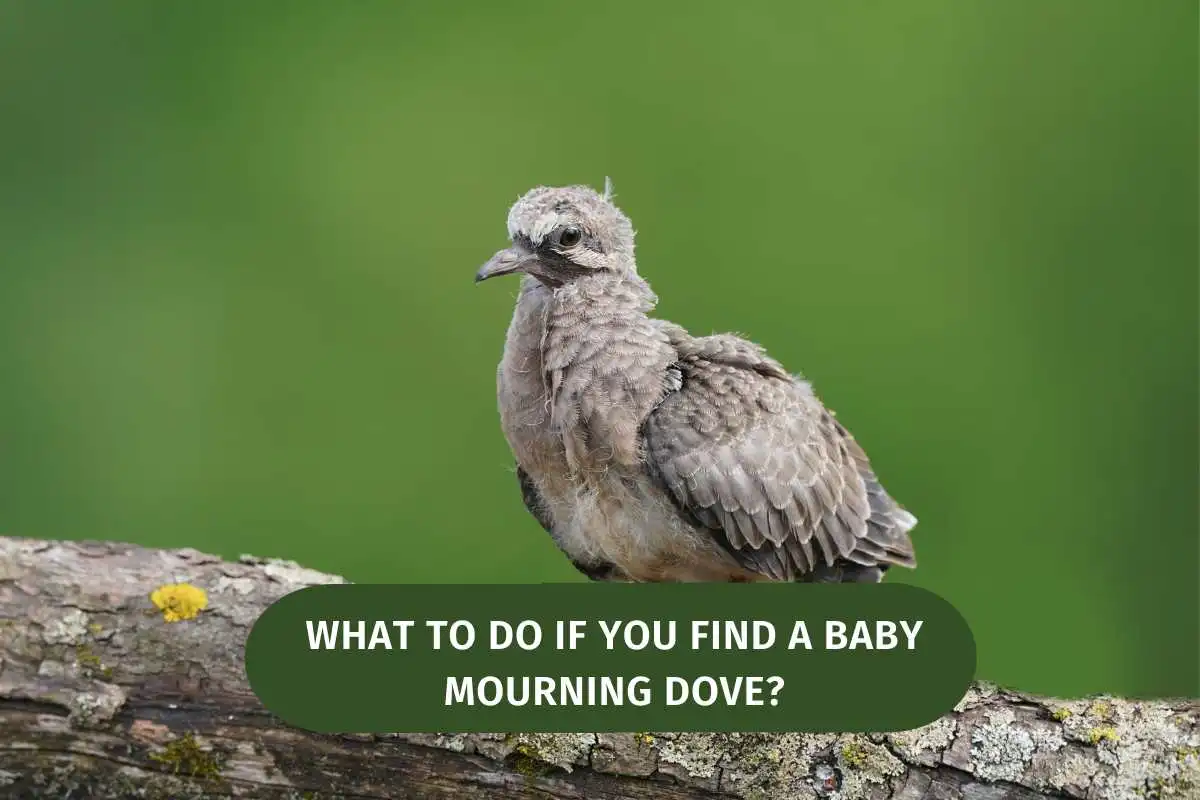Finding a baby mourning dove, a, can be a heartwarming and exciting experience. However, it’s important to approach the situation carefully and consider the best course of action for the bird.
Here are some guidelines for what to do if you find a baby mourning dove:
- Determine if the bird is in immediate danger: If the baby mourning dove is in a place where it is at risk of being injured or killed, such as in the middle of a busy road, move it to a safer location. Be sure to use gloves or a towel to handle the bird, as your scent can interfere with its ability to be returned to the wild.
- Check for injuries: Look for any visible injuries or signs of distress, such as bleeding or difficulty breathing. If the bird appears to be severely injured or sick, it may need medical attention from a veterinarian.
- Consider the bird’s age: Baby mourning dove can usually leave the nest and be on their own within a few weeks of hatching. If the baby pigeon has feathers and can move around on its own, it may be learning to fly and should be left alone to practice. However, if the pigeon is naked or covered in down and cannot move around, it may be too young to be on its own and may need assistance.
- Contact a wildlife rehabilitation center: If the baby mourning dove is injured or too young to be alone, contact a local wildlife rehabilitation center for assistance. These centers have trained staff who can provide the necessary care and support to help the pigeon recover and eventually be released back into the wild.
- Do not try to raise the pigeon yourself: It is generally not recommended to try to raise a baby dove yourself, as it requires specialized knowledge and equipment to provide the proper care. Pigeons also require a specific diet that may be difficult to replicate at home. It is best to leave the care of the pigeon to trained professionals at a rehabilitation center.
What do you do if you find a baby mourning dove on the ground?
If you come across a baby mourning dove on the ground, you should not pick it up or try to bring it home with you. Instead, you should observe the chick from a distance to see if the parents provide food and care.
If the chick appears distressed or has been abandoned, you can contact a local wildlife rehabilitation center or veterinarian.
Suppose the chick is in immediate danger, such as if it is in the middle of a busy road, you can try to move it to a safer location nearby. However, it is generally best to avoid handling wild birds if possible, as human contact can be stressful for them and may interfere with their development.
How long do baby mourning doves stay on the ground?
Baby mourning doves, also known as nestlings, typically leave the nest and spend some time on the ground when they are about two weeks old.
At this age, they have developed feathers and can hop and flutter but cannot fly yet. They may spend several days on the ground, hopping and fluttering about, before they can fly. During this time, the parents may continue to feed and protect the fledglings.
It is important to note that it is not uncommon for baby birds, including mourning doves, to leave the nest and spend some time on the ground before they can fly. This is a natural part of their development and should not be cause for concern.
Baby Mourning dove growth stages
Here is a table outlining the growth stages of baby mourning doves:
| Growth Stage | Description |
| Egg | Mourning doves lay eggs that are about 1 inch long and are white or cream-colored. The eggs are incubated for about two weeks. |
| Hatchling | When the eggs hatch, the babies, called hatchlings, are naked and have closed eyes. They are fed a special secretion called “pigeon milk” produced by their parents. |
| Nestling | As the nestlings grow, they develop feathers and their eyes open. They are still fed pigeon milk, but also begin to be fed small insects and other invertebrates by their parents. |
| Fledgling | When the nestlings are ready to leave the nest, they are called fledglings. They are able to fly and forage for their own food, but may still receive some feeding and protection from their parents. |
When the nestlings are ready to leave the nest, they are called fledglings. They are able to fly and forage for their own food, but may still receive some feeding and protection from their parents.
It is important to note that it is not recommended to interfere with the natural growth and development of wild birds, including baby mourning doves. If a baby dove is orphaned or abandoned and needs to be hand-raised, it is important to follow the guidance of a veterinarian or experienced bird rehabilitator.
What do you feed a baby dove that is fully feathered?
If you are caring for a baby dove in a rehabilitation setting, providing a diet that meets the chick’s nutritional needs is important. A sample feeding schedule for a fully feathered baby dove is provided below:
| Time of Day | Food | Amount |
| Morning | Insects (e.g. mealworms, crickets) | 1-2 tablespoons |
| Midday | Seed (e.g. millet, canary seed) | 1-2 tablespoons |
| Evening | Insects (e.g. mealworms, crickets) | 1-2 tablespoons |
It is important to provide fresh food and clean water for the chick at each feeding. The chick’s diet may need to be adjusted as it grows and develops, so it is important to work closely with a veterinarian or rehabilitation specialist to ensure the chick receives the proper nutrition.
How do you feed a baby mourning dove?
It is not recommended to feed baby mourning doves as they need to learn how to forage and find food on their own. In the wild, their parents would feed them a variety of insects and other small invertebrates.
If a baby mourning dove has been orphaned or abandoned and needs to be hand-raised, it is important to use a specialized formula designed for feeding baby birds. This can be purchased from a bird supply store or veterinarian.
The formula should be fed using a small spoon or eyedropper. It is important to follow the instructions on the formula packaging and consult with a veterinarian or experienced bird rehabilitator for guidance on how to feed and care for the baby dove properly.
Did I answer everything you want to know about what to do if you find a baby mourning dove?
Baby mourning doves, also known as nestlings, typically leave the nest and spend some time on the ground when they are about two weeks old. At this age, they have developed feathers and are able to hop and flutter, but are not yet able to fly.
They may spend several days on the ground, hopping and fluttering about, before they are able to fly. During this time, the parents may continue to feed and protect the fledglings.
It is important to note that it is not uncommon for baby birds, including mourning doves, to leave the nest and spend some time on the ground before they are able to fly. This is a natural part of their development and should not be cause for concern

